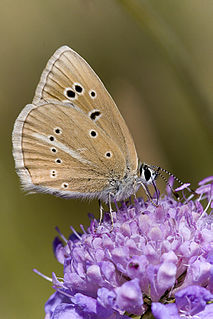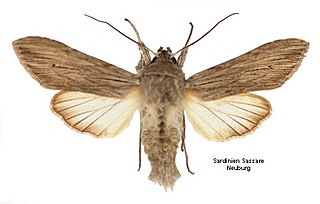
The numbat, also known as the noombat or walpurti, is an insectivorous marsupial. It is diurnal and its diet consists almost exclusively of termites.

The banded krait is a species of elapid snake found on the Indian Subcontinent and in Southeast Asia. It is the largest species of kraits, with a maximum length up to 2.7 m.

The marbled green is a moth of the family Noctuidae. The species was first described by Johann Reinhold Forster in 1771. It is found in Europe. Its wings are white with several shades of green. However, the green fades.

Trichius fasciatus, the Eurasian bee beetle, is a beetle species belonging to the family Scarabaeidae, subfamily Cetoniinae.

Xylomyidae is a family of flies known commonly as the wood soldier flies. They are xylophagous and are associated with dead or dying wood.

Schinia, commonly called flower moths, is a large genus of moths belonging to the family Noctuidae. The genus has a Holarctic distribution with the vast majority of species being found in North America, many with a very restricted range and larval food plant.
Fauna Europaea is a database of the scientific names and distribution of all living multicellular European land and fresh-water animals. It serves as a standard taxonomic source for animal taxonomy within the Pan-European Species directories Infrastructure (PESI). As of June 2020, Fauna Europaea reported that their database contained 235,708 taxon names and 173,654 species names.

Miltochrista miniata, the rosy footman, is a moth of the family Erebidae. The species was first described by Johann Reinhold Forster in 1771. It is found in the temperate parts of the Palearctic realm – Europe, Asia Minor, Caucasus, northern Kazakhstan, southern Siberia, Amur, Primorye, Sakhalin, southern Kuriles, Heilongjiang, Liaoning, Hebei, Inner Mongolia, Shanxi, Sichuan, Korea and Japan, but may be replaced by Miltochrista rosaria in the eastern Palearctic.

Arion circumscriptus, common name brown-banded arion, is a species of air-breathing land slug, a terrestrial pulmonate gastropod mollusk in the family Arionidae. It is commonest in woodland, occurring across most of Europe, except for more southern regions, and is also widespread in North America. It has been argued that A. circumscriptus is best considered a colour morph of Arion fasciatus.

Panagaeus is a genus of ground beetle native to the Holarctic, the Near East, and North Africa. It contains the following species:

Polyommatus (Agrodiaetus) fulgens is a species of butterfly in the family Lycaenidae. It is found in the north and north-east of Spain.
Elipsocus fasciatus is a species of psocopteran from the Elipsocidae family. It is endemic to the Canary Islands.

Cucullia tanaceti is a moth of the family Noctuidae. The species was first described by Michael Denis and Ignaz Schiffermüller in 1775.

Hoplodrina superstes, also known as the powdered rustic, is a moth of the family Noctuidae, first described by Ferdinand Ochsenheimer in 1816. It is found in Asia and Europe.

Panchrysia aurea is a moth of the family Noctuidae. It is found in southern Europe and western and central Asia. The range extends from Portugal, east to Tian Shan, the Altai and the north-western Himalayas. In central Europa, it is found in the southern Alps, lower Austria and the mountains on the Balkan Peninsula.

Stizus is a genus of sand wasps belonging to the family Crabronidae. There are over 100 species.

Stizus fasciatus is a species of sand wasps belonging to the family Crabronidae.

Lockington Marshes is an 11.3 hectare biological Site of Special Scientific Interest north of Ratcliffe on Soar in Leicestershire.

Anthribus nebulosus is a species of fungus weevil, family Anthribidae. It is found in Europe, Near East, and Northern Asia and, as an introduced species, in North America.

Anthribus is a genus of fungus weevils in the family Anthribidae.
















